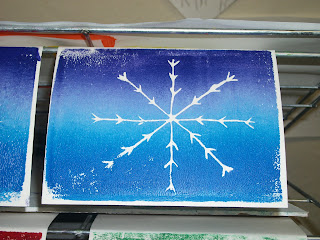A project must be due this week in Social Studies – the art studio has been abuzz with 8th graders bearing passes. The 8th grade doesn’t have art until next semester, but with a project due and a deadline looming, some find their way to the art room to beg materials or use the studio.
 |
| Giant Bowl with Kanji, by "S," Garde 8 |
The theme must be Japan – Some students remembered the Sumi-e (Japanese ink painting) that was set up last year, and ask to get that out. Some head to the sculpture center and become architects. Online sources are employed to translate names and words into kanji, which are then brushed onto clay bowls or scroll paintings. Last month the studio was alive with civil war themes: faded, discolored letters from the front, scrapbooks with stiched samplers, 3-D battle scenes and all kinds of weaponry.
Arts integration in school programs often is employed to make learning more vivid or to showcase cultural aspects of the material being studied. Students report that they learn best when they can learn about a topic through the arts. Usually, it is the teacher who “integrates” art into core subject matter, so it is interesting from my point of view to observe students in the art studio doing the integrating for themselves – in effect, using visual art to “show what they know.”
As the teacher in the room facilitating this process, I have the opportunity to extend the learning by offering references and resources, suggesting areas for further inquiry or helping to make connections to both the artworld and world at large. There is some question about the extent of transference of learning from art to other disciplines – a question that contemporary researchers are busy studying. I can attest that from my vantage point behind the art apron that the skills and content knowledge acquired in the art studio are synthesized and employed by this group of students as they investigate and assimilate new information in their other classes at school.












